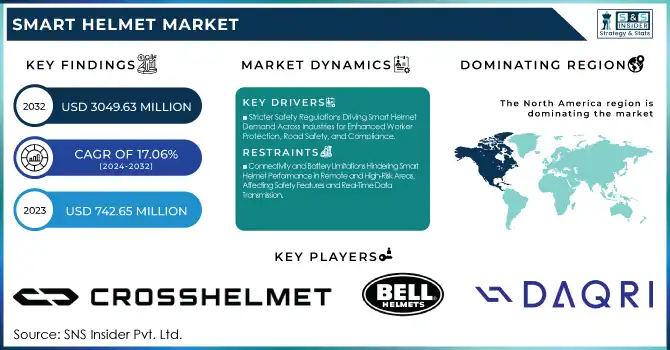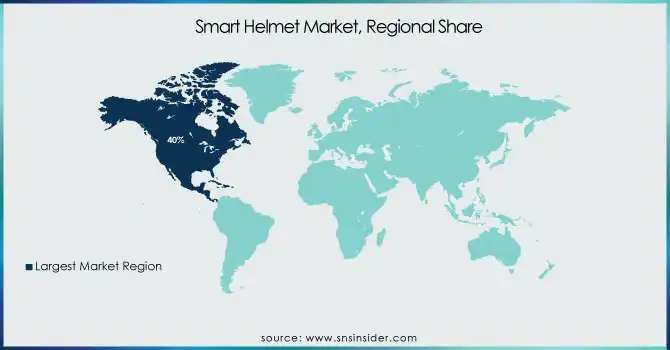Smart Helmet Market Report Scope & Overview:
The Smart Helmet Market was valued at USD 742.65 million in 2023 and is expected to reach USD 3049.63 million by 2032, growing at a CAGR of 17.06% from 2024-2032. This report includes an in-depth analysis of key factors driving market growth, including adoption rates, technological advancements, and shifts in consumer behavior. With increasing demand for safety and connectivity, the market is witnessing innovations such as integrated communication systems and augmented reality. Price trends and supply chain dynamics further influence market strategies. Consumer preferences for advanced features in sectors like construction, sports, and transportation are driving the surge in smart helmet adoption. This growth trajectory reflects both technological and societal shifts toward enhanced personal safety.

To Get more information on Smart Helmet Market - Request Free Sample Report
Smart Helmet Market Dynamics
Drivers
-
Stricter Safety Regulations Driving Smart Helmet Demand Across Industries for Enhanced Worker Protection, Road Safety, and Compliance.
Growing government regulations for driver and worker safety are propelling the smart helmet adoption among industries such as construction, mining, and transport. Governmental bodies are enforcing more stringent workplace safety standards to reduce accidents and fatalities, forcing businesses to spend on advanced protective equipment. In transport, growing concerns regarding road safety are compelling motorcyclists to adopt smart helmets with built-in safety aspects such as crash detection and emergency notification. Furthermore, industrial industries are utilizing these helmets to promote worker safety by detecting hazards in real-time and through communication functions. With heightened enforcement of safety regulations, companies are focusing on compliance, and this is boosting demand for technology-enabled helmets with IoT, AI, and AR features to maximize protection and operating efficiency.
Restraints
-
Connectivity and Battery Limitations Hindering Smart Helmet Performance in Remote and High-Risk Areas, Affecting Safety Features and Real-Time Data Transmission.
Smart helmets with sophisticated technologies such as IoT, AI, and AR need constant internet connectivity and stable battery power to perform optimally. In remote areas like mines, construction sites, and high-risk industrial areas, though, maintaining constant network coverage is a huge challenge. Low connectivity can interrupt real-time data transmission, and the efficiency of safety features such as hazard detection and emergency warnings will be diminished. Secondly, battery capacity limitations limit extensive usage, needing to be frequently charged, which in some harsh work environments might not always be convenient. All these pose difficulties for smooth running and uptake, especially in businesses where continuous performance is paramount. The solution of these problems in terms of extended battery life and offline functionality is paramount for general market uptake.
Opportunities
-
AI and IoT Integration Boosting Smart Helmet Safety, Real-Time Monitoring, and Communication for Enhanced Worker and Rider Protection.
The convergence of artificial intelligence (AI) and the Internet of Things (IoT) is revolutionizing smart helmets by enhancing safety, communication, and real-time monitoring. AI-driven features like predictive analytics and voice recognition facilitate proactive hazard detection, minimizing accident risks in industrial and transportation environments. IoT connectivity facilitates smooth data transmission, improving situational awareness for workers, motorcyclists, and security officers. Real-time monitoring and emergency notifications enhance response times in accidents, and thus safety is better ensured. Moreover, automation with AI facilitates hands-free interaction, and thus smart helmets are more effective in hazardous environments. With technology growing by the day, the use of AI and IoT will play a major role in increasing adoption, offering industries cutting-edge solutions for enhanced operational efficiency and labor protection.
Challenges
-
Varying Safety Regulations Creating Compliance and Certification Barriers for Smart Helmet Market Expansion
Various industries and nations have their own safety standards, and it is challenging for smart helmet producers to obtain uniform certification and compliance. Regulatory differences necessitate companies to adjust designs and features to comply with particular regional regulations, which adds to production costs and time-to-market. This non-standardization also makes global distribution more challenging, restricting market growth opportunities. Such industries as construction, mining, and logistics need to comply with domestic regulations, which can impede adoption rates. Moreover, changing safety standards require constant upgrades in smart helmet technologies, imposing still more challenges on manufacturers. The implementation of common standards and streamlined certification procedures would substantially facilitate market access and promote wider adoption in various industries and regions.
Smart Helmet Market Segment Analysis
By Component
The Communication segment led the Smart Helmet Market with the largest revenue share of approximately 38% in 2023 because of the increasing need for hassle-free connectivity in industrial, defense, and transport applications. Smart helmets that have real-time voice communication, Bluetooth, and IoT integration improve workplace safety and operational efficiency. The construction and mining industries use hands-free communication for better coordination. Further, the use of smart helmets among motorcyclists and law enforcers helped strengthen the market presence of this segment.
The Navigation segment is anticipated to grow at the fastest CAGR of 18.90% during the period 2024-2032, fueled by the expanding use of smart helmets in motorcycling, logistics, and outdoor sports. GPS-based navigation, AR screens, and turn-by-turn instructions are enhancing user experience and safety. The growing use of electric two-wheelers and increasing demand for advanced rider assistance systems are also driving the growth of the segment, which is making navigation a key feature for the adoption of smart helmets.
By Type
The Full Face segment led the Smart Helmet Market with the largest revenue share of around 54% in 2023 because of its higher level of safety and protection capabilities, which is why it is the most sought-after among motorcyclists, industrial workers, and defense personnel. These helmets are more impact-resistant, have in-built communication, and augmented reality capabilities, and thus provide complete safety. More regulations for rider protection and higher adoption in motorsports and professional biking also drove demand higher, cementing the segment's market leadership.
The Hard Hat market is projected to expand at the fastest CAGR of 19.82% during the forecast period from 2024 to 2032, led by rising workplace safety standards in construction, mining, and manufacturing sectors. Rising investments in intelligent personal protective equipment (PPE) with IoT-based hazard recognition, real-time connectivity, and ambient monitoring are boosting adoption. With industries focusing on worker safety and compliance, the need for smart hard hats is increasing, and this segment is a major growth driver in the market.
By End-Use
The Consumer segment led the Smart Helmet Market with the largest share in terms of revenue of approximately 74% in 2023, fueled by the growing usage of smart helmets among motorcyclists, cyclists, and adventure sports participants. The presence of features such as Bluetooth connectivity, voice command, crash detection, and navigation has improved convenience and safety for users, thereby increasing demand. Furthermore, growing road safety concerns and regulations compelling the use of helmets have further contributed to market growth, positioning the consumer segment as the most significant revenue contributor.
The Manufacturing segment is expected to grow at the fastest CAGR of approximately 20.21% during 2024-2032, driven by the rising concern for worker safety and work efficiency. The use of smart helmets with IoT-based monitoring, live communication, and augmented reality to provide hands-free guidance is revolutionizing industrial environments. Stringent safety laws and the drive to Industry 4.0 technologies are increasingly promoting the adoption of smart helmets in manufacturing, fueling explosive market growth.
Regional Analysis
North America led the Smart Helmet Market with the largest revenue share of approximately 40% in 2023, fueled by strict safety regulations, high consumer consciousness, and high-tech adoption. The high presence of prominent market players and rising investments in smart protective equipment in industries like construction, defense, and motorcycling have driven demand. Moreover, growing disposable income and an increasing inclination towards connected safety solutions have driven the region's market leadership.
Asia Pacific will expand at the fastest CAGR of approximately 18.82% during 2024-2032, driven by urbanization, growing industrialization, and growing safety issues across industries. The growth in two-wheeler ownership, along with tighter government regulations for the safety of riders, is fueling consumer adoption. Increasing manufacturing and construction sectors, coupled with increasing investments in intelligent industrial safety gear, are further driving market growth, with Asia Pacific being the fastest-growing region in the smart helmet market.

Get Customized Report as per Your Business Requirement - Enquiry Now
Key Players
-
Beijing BaBaALi Technology Co.Ltd (Smart Helmet, Smart Visor)
-
Crosshelmet (Crosshelmet X1, Crosshelmet S1)
-
Bell Helmets (Qualifier DLX MIPS, Star MIPS)
-
Forcite Helmet Systems (Forcite MK1, Forcite MK1S)
-
Intelligent Cranium Helmets LLC (ICH-001, ICH-002)
-
JARVISH INC (X-AR Helmet, AR Helmet)
-
LIVALL Tech Co., Ltd. (BH51M, BH60SE)
-
H&H Sports Protection USA, Inc. (TORC T15, TORC T50)
-
Sena Technologies, Inc. (Momentum INC, Cavalry Bluetooth Helmet)
-
Lumos Helmet US (Lumos Matrix, Lumos Kickstart)
-
DAQRI (DAQRI Smart Helmet, DAQRI AR Smart Helmet)
-
Forcite Helmet Systems Pty Ltd. (Forcite MK1, Forcite MK1S)
-
TVS Motor Company (TVS Smart Helmet, TVS Blaze Helmet)
-
Hedkayse (Hedkayse ONE, Hedkayse REACT)
-
MapmyIndia (Connected Smart Helmet, Location-Based Services Helmet)
-
Livall (BH51M, BH60SE)
-
Jarvish Inc. (X-AR Helmet, AR Helmet)
-
Torc Helmets (Torc T50, Torc T15)
-
Lumos Helmet (Lumos Matrix, Lumos Kickstart)
-
Nexsys. Co., Ltd. (Nexsys Smart Helmet, Nexsys Vision Helmet)
-
360fly, Inc. (360fly Camera Helmet, 360fly Sport Helmet)
Recent Developments:
-
At CES 2024, LIVALL officially launched the MC1 smart motorcycle helmet, marking its expansion into high-speed cycling gear. The MC1 features Bluetooth connectivity, smart lighting, and safety innovations, reinforcing LIVALL’s position in the smart helmet industry.
-
In 2024, TORC Helmets launched the Newport Carbon Fiber Gloss Black helmet, featuring a 3K carbon fiber shell, antimicrobial suede interior, multi-density EPS, and integrated speaker pockets. The helmet is DOT and ECE certified, offering high safety and comfort for riders.
| Report Attributes | Details |
|---|---|
| Market Size in 2023 | USD 742.65 Million |
| Market Size by 2032 | USD 3049.63 Million |
| CAGR | CAGR of 17.06% From 2024 to 2032 |
| Base Year | 2023 |
| Forecast Period | 2024-2032 |
| Historical Data | 2020-2022 |
| Report Scope & Coverage | Market Size, Segments Analysis, Competitive Landscape, Regional Analysis, DROC & SWOT Analysis, Forecast Outlook |
| Key Segments | • By Type (Full Face, Half Face, Hard Hat) • By Component (Communication, Navigation, Camera, Others) • By End-Use (Consumer, Manufacturing, Construction, Others) |
| Regional Analysis/Coverage | North America (US, Canada, Mexico), Europe (Eastern Europe [Poland, Romania, Hungary, Turkey, Rest of Eastern Europe] Western Europe] Germany, France, UK, Italy, Spain, Netherlands, Switzerland, Austria, Rest of Western Europe]), Asia Pacific (China, India, Japan, South Korea, Vietnam, Singapore, Australia, Rest of Asia Pacific), Middle East & Africa (Middle East [UAE, Egypt, Saudi Arabia, Qatar, Rest of Middle East], Africa [Nigeria, South Africa, Rest of Africa], Latin America (Brazil, Argentina, Colombia, Rest of Latin America) |
| Company Profiles | Beijing BaBaALi Technology Co.Ltd, Crosshelmet, Bell Helmets, Forcite Helmet Systems, Intelligent Cranium Helmets LLC, JARVISH INC, LIVALL Tech Co., Ltd., H&H Sports Protection USA, Inc., Sena Technologies, Inc., Lumos Helmet US, DAQRI, Forcite Helmet Systems Pty Ltd., TVS Motor Company, Hedkayse, MapmyIndia, Livall, Jarvish Inc., Torc Helmets, Lumos Helmet, Nexsys. Co., Ltd., 360fly, Inc. |

